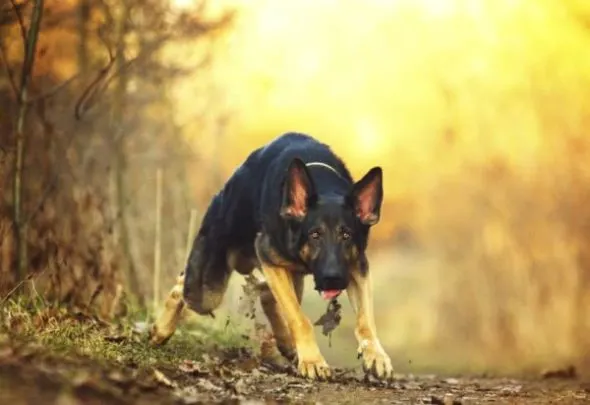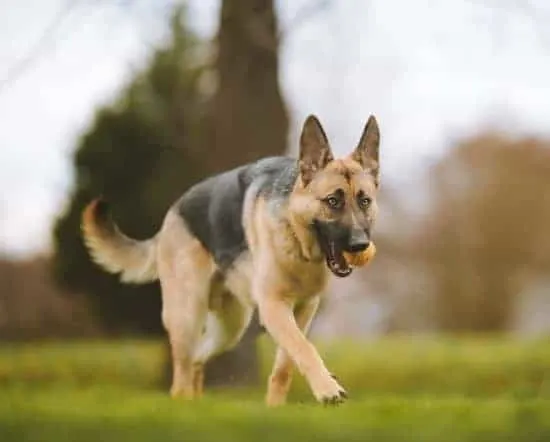Why Are German Shepherds Backs Sloped? Controversial Modern GSD Breed Standard
German Shepherds as a dog breed got their start back in the late 19th century. Breed journals suggest that the father of the entire breed line may have even been a wolf-dog hybrid.
While the earliest German Shepherd dogs definitely had a leaner, more wolf-like appearance, the German Shepherd dog we know and love today is larger, heavier, stronger and has a distinctly different coat and color than a wild wolf.
One of the biggest questions about the breed’s evolution revolves around that sloping German Shepherd’s back.
Why do GSDs have a sloped back? Is this normal? Why don’t all dog breeds have a sloping back?
We will take a close look at this controversial issue here.
Why Are German Shepherds Back Sloped?
There is no evidence in the original breed standard developed by the breed’s founder, Captain Max von Stephanitz, that the German Shepherd dog is supposed to have a visibly sloped back.
Many breeders and owners are now starting to suspect that the sloped back is due to a skeletal deformity caused by intensive interbreeding to specific appearance standards.
German Shepherds’ Sloped Backs: A Controversial History
As The Independent explains, a public outcry began after video footage of the 2016 winner of the Crufts competition, a German Shepherd, who appeared to be struggling to move.
The public got very upset and many questioned whether the exaggerated slope of the dog’s back was behind the dog’s obvious anxiety and hesitation to obey the trainer’s commands.
While the owner of that dog, Susan Cuthbert, pushed back, saying her German Shepherd had been passed through with a clean bill of health to compete, people around the world have accused the owner and the dog show of animal cruelty.
Since then, a BBC film called “Pedigree Dogs Exposed” fanned the flames when it took a look at “then and now” pictures of early German Shepherds and GSDs today.
The change in appearance is obvious even to casual viewers.
In fact, as The Telegraph later reported, as a result of the international upset, the Crufts dog show actually changed their own entry rules following the 2016 show results.
The report by the Royal Veterinary College highlighted survey results from 430 clinics in its report of exaggerated breed standards and how they are causing cruel health problems for German Shepherd dogs today.
Our YouTube Video On The Sloped German Shepherd Back
Watch a Video of the 2016 German Shepherd Dog Winning “Best in Show”
You can watch the actual footage from the 2016 Crufts dog show where the German Shepherd contestant appeared to be lame and struggling to comply with the exhibition trainer’s commands during the contest.
Viewers were very upset over the judges’ decision to award the dog “Best in Show” and even to let the dog compete at all.
What Is a German Shepherd Breed Standard?
If you are brand new to caring for dogs or to the German Shepherd dog breed, you may be understandably confused about what a “breed standard” even is or why it is important.
Breed standards are typically developed by breed clubs that actively participate in either working dog or show dog competitions.
Breed standards can differ quite a bit based on whether the dog breed in question is a working dog breed or a show dog breed.
The former tends to focus its breed standard on temperament and performance traits, while the latter tends to focus its breed standard on how the dog looks, or appearance traits.
The German Shepherd was originally developed as an exclusively working dog breed.
Captain Max von Stephanitz, the breed’s founder, was said to have cared little for what his dogs looked like as long as they performed their jobs to perfection.
As the German Shepherd Dog Club of America points out, however, Captain von Stephanitz was also known to heavily interbreed his original dogs to obtain a certain level of mental stability and work ethic.
This later caused some genetic flaws, and so Captain von Stephanitz decided to introduce some unrelated herding dog DNA through expanded breeding to get rid of these flaws.
What this points to is an essential flaw in the development of any dog breed standard.
Any time animal breeding is manipulated to reliably produce certain desirable traits, there is always a risk of introducing health or temperament problems.
Today, German Shepherds are tested for a number of known heritable (genetic) health issues for this very reason, which we will discuss more here shortly.

Understanding the Two Different GSD Breed Lines: Working and Show
As Von Geliebtem Haus GSD breeder and kennels so clearly explain, there are actually several different German Shepherd breed standards in use today for both appearance (show) and working dog lines.
These are the main GSD lines that most breeders work with:
- American show dog line.
- West German show dog line.
- West German working dog line.
- Czech working dog line.
- East German (DDR) dog line.
As you have probably already noticed, only two lines are devoted to the show or appearance standard for German Shepherd dogs. The other three lines focus exclusively on working dog traits.
So let’s take a look at the similarities and differences between each of the major GSD breed lines.
American show dog line
These dogs are known to be stockier, heavier, taller, and more prone to thin bones, thin heads, and health issues overall.
West German show dog line
The West German show dog line is also a larger and heavier dog than the other working dog lines and these dogs typically look very similar to one another in every way, from coat color and pattern to size, height, and weight.
West German working dog line
Many breeders believe the West German working dog line is the “original” line developed by breed founder Captain Max von Stephanitz.
Certainly, these dogs are leaner and lighter-weight and look more like their rumored wolf-hybrid breed father.
Czech GSD working dog line
The German Shepherd dogs that come from this lineage are primarily from the Pohranicni Straze kennel, a kennel used nearly exclusively by the Czech military.
Their primary work duties are border patrol and military jobs.
East German (DDR) working dog line
This line of German Shepherd dogs originated in East Germany and has maintained a distinctive appearance and body structure.
However, the temperaments of dogs from this breed line are known to vary, and not all make effective working dogs.

Why Do GSD Breeders Have to Health Test Their Parent Dogs?
As the Canine Health Information Center (CHIC) points out, most purebred dog breeds today have certainly known potentially heritable (genetic) health issues that occur more commonly in those dog breeds.
This is because these dogs have been closely bred to conform to either a working or show (appearance) breed standard.
When this happens, the breeder is deliberately selecting parent dogs based on certain desirable traits rather than on overall health.
When this type of breeding program is pursued, it can lead to genetic weaknesses that are passed along to the puppies.
For the German Shepherd dog breed, the major known genetic weaknesses that responsible breeders are required to test for include these:
- Hip and elbow dysplasia
- Temperament
- Cardiac
- Autoimmune thyroiditis
- Degenerative myelopathy
- Eye issues
These are not insignificant issues, and the most concerning in terms of the sloping back many show line German Shepherds show today is hip and elbow dysplasia.
Dysplasia is a word that is used to describe cellular malformation on a wide scale. When applied to the hip or elbow socket, it refers to a socket that doesn’t fully conform to the ball joint.
When a German Shepherd inherits hip or elbow dysplasia, what this means is that the dog’s hip or elbow joints won’t form properly and the dog will be lame. The condition can range from mild to crippling.
The treatment for mild dysplasia is typically medication and nutritional supplements plus physical therapy.
The only treatment for severe dysplasia is surgery – a full hip or elbow joint replacement is necessary to treat the condition.

What Is a “Hock Walking” German Shepherd?
As Winter Park Veterinary Hospital explains, when a German Shepherd is bred exclusively for adherence to a specific breed standard, whether that be for temperament or for appearance, there is always a risk of introducing genetic weakness.
For the German Shepherd dog, the conformation weakness appears to have centered around the spinal and skeletal system development, as BioMed Central’s Springer Nature journal points out.
German Shepherd dogs today are not only known for being prone to hip and elbow dysplasia and degenerative myelopathy, a condition where the lower portion of the spine begins to literally disintegrate in later life, and osteoarthritis.
Hock walking is another more recent condition that has become more common in purebred German Shepherd dogs today.
Ortho Dog explains that the “hock” is basically the same as a dog’s ankle.
Hock walking occurs when the angle of a German Shepherd’s lower spine is curved to a degree where it causes the ankle and not the foot to touch the ground.
Sometimes the dog will walk on both hocks (instead of on both feet).
Sometimes the dog will walk on one hock and struggle to place the other foot completely on the ground. All kinds of imbalances can arise when the dog’s spine does not grow properly.
A variety of treatments, including physical therapy, a system of stabilizing braces, medications and surgery may be needed to address these musculoskeletal malformations in German Shepherd dogs.

PinPoint Veterinary Care does a great job of explaining exactly how exaggerated this sloping lower back has become in the German Shepherd dog and what it might look like if the same type of breeding program was followed for horses.
The diagrams the clinic provides clearly illustrate how there should be a basic 90-degree angle between the drop-off from the spinal column and the descent of the back legs.
When this is missing because the spinal column itself is exaggerated in its slope downward, it then means the dog must muster ever more strength, coordination, and accuracy to walk, run, jump and move with ease.
The veterinary clinic emphasizes that current pre-show testing protocols have limitations in terms of assessing whether an exaggerated spinal slope is actually causing movement or quality of life issues in the dogs.
It is because of this that breeding towards an exaggerated appearance standard for the purposes of winning dog shows is becoming less and less tolerated outside the community of purebred dog breeders.
In most cases, German Shepherd owners are much more interested in owning a healthy dog that can be happy as a family companion and personal protection dog, doing things they love like digging!
Most owners have no interest in showing their dogs and never will.
Sloped German Shepherd Backs: What to Know About GSD Back Problems
It is very important to work with a responsible German Shepherd breeder that puts the health of their puppies before any type of breed standard.
You have every right to ask for and view the results of all parent dog pre-testing (to CHIC database standards as mentioned here earlier).
But keep in mind that current show standards may not be as rigorous in the sense of assessing whether your puppy’s future life quality may be impacted by back slope, hock walking, or dysplasia issues.
This is why it is so important to meet the parent dogs yourself and see whether the dogs have a normal back or the exaggerated slope you saw in the Crufts video here earlier.
By doing this extra pre-purchase puppy research and homework, you can save yourself potentially years of heartache and tens of thousands of dollars in veterinary care – and have a much greater chance of choosing a healthy German Shepherd puppy to add to your family.































